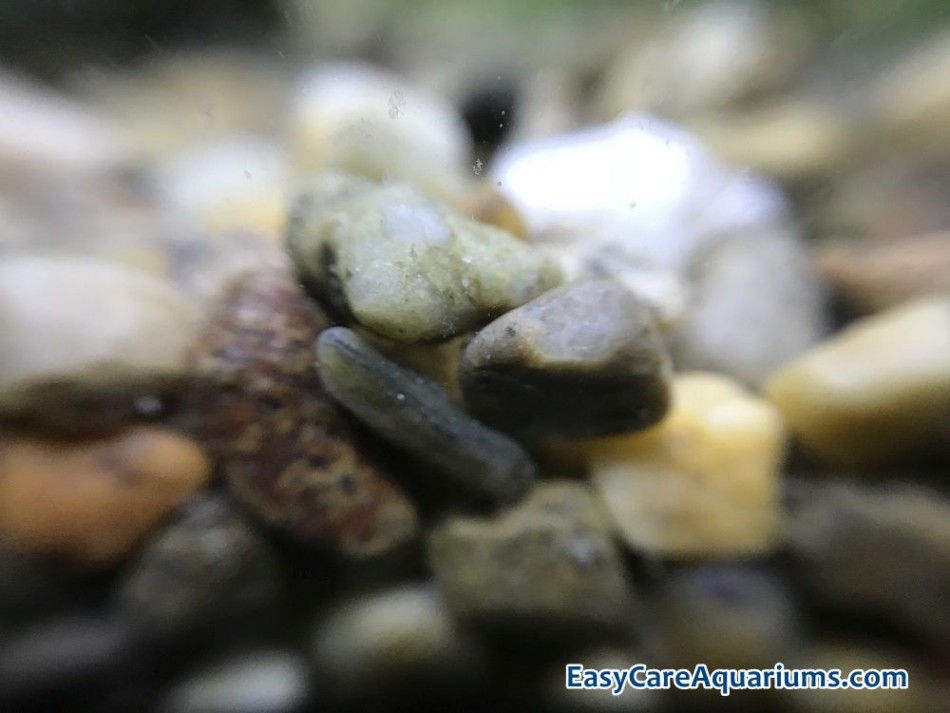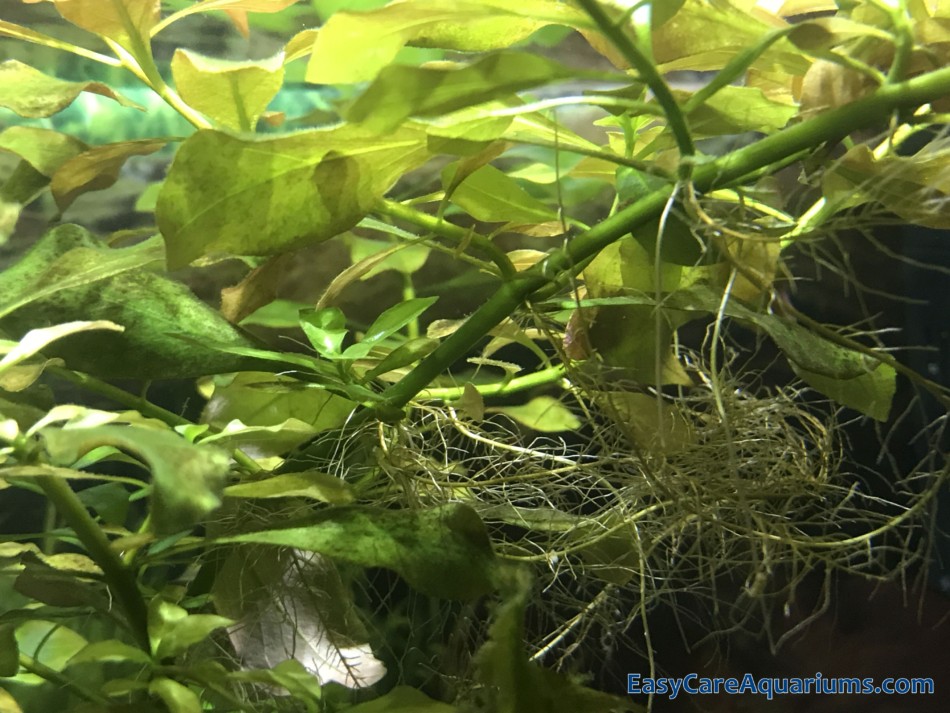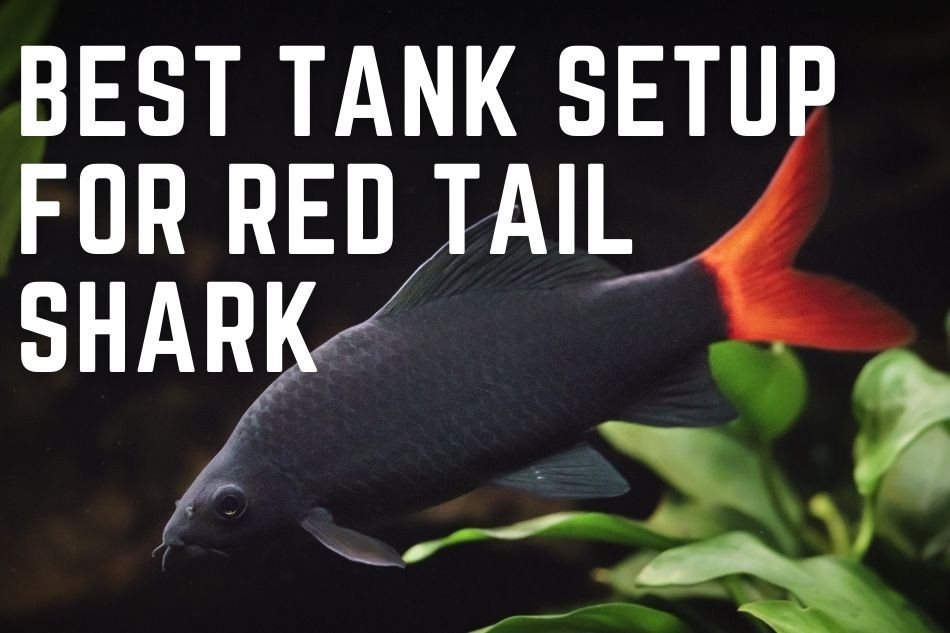This article may contain some affiliate links to products. The links provide me a small percentage of commission but do not cost you anything extra to use. (See full disclosure statement here ).
).
Once you know what kind of tank environment is best for your Red Tail Shark it’s easy to create it. You can keep things simple and still give your fish a home they will thrive in.
The best tank setup for Red Tail Shark is one that includes lots of plants, low to moderate lighting and a fast flowing current. Because they are a tropical fish the water needs to be warm, clean and oxygenated. Adding rocks, pebbles and leaf litter is a good idea too. You can also add driftwood and cave structures to make things feel more natural.
Whether you’re setting up a Red Tail Shark only tank, or building up a community tank, you can keep things easy-care.
In this article I’ll be explaining how to set up a freshwater tank for your Red Tail Shark. I’ll also be giving you some information and tips about adding them to, or building up, a community tank that includes the Red Tail Shark.
Let’s start with getting the tank size right and then we’ll go on to the best setup.
Important Tip: Red Tail Shark are known to be aggressive and territorial. You should only keep 1 Red Tail Shark in your aquarium. If you want to keep more than one you will need to keep a group of a least 6, preferably in a large species only aquarium. This will help to reduce aggression. Even so, you still need to be prepared for some infighting.
Choosing A Tank For Your Red Tail Shark
Although the Red Tail Shark isn’t considered to be a large freshwater aquarium fish it’s not a nano fish either. The average length of a Red Tail Shark, once it’s fully grown, is around 6 inches (15.2 cm). Which means that if you want to keep this fish you’re going to need a fair sized tank.
It’s also worth bearing in mind that Red Tail Shark can live up to approximately 5 -6 years. So it’s worth getting the tank size right at the beginning or you’ll have to buy a bigger one later on. You’ll save yourself some money by getting a larger tank to start with.
Tip: A long tank is better for Red Tail Shark than tall one. These fish need plenty of swim-room and also space to turn around in.
What Size Tank Do Red Tail Shark Need?
The tank size you will need for your Red Tail Shark will depend on a few things. When choosing a tank it’s best to take the points on the list below into consideration before buying one.
- Even a single Red Tail Shark needs plenty of swim- room
- Allow room for lots of plants
- If your Red Tail Shark is going to share the tank with other fish allow room for them too
- Allow room for their tankmates fry (babies) if they’re likely to breed
- A species only tank of Red Tail Shark (minimum 6 fish) means you need an extra large tank to reduce fighting
My advice is to decide at the outset whether you will just keep one Red Tail Shark on its own, a community tank, or a Red Tail Shark species only aquarium, before you buy a tank.
It’s important to make your plan first because the amount of fish you want to keep makes a difference to the size of tank you’re going to need.
You can always ask your local Pet Store or Aquatic Dealer for some advice if you’re not sure
Tank Size Based On 1 Red Tail Shark
The minimum tank size for 1 Red Tail Shark is a 20 gallon long (Approx. UK 90.9 Litres/US 75.7 Litres). This size tank can be okay if it’s long rather than tall. And also if you have very few, or no tankmates. But a bigger tank is better.
The next step-up in tank size for 1 Red Tail Shark is a 40 gallon long (Approx. UK 181.8 Litres/US 151.4 Litres). Doubling the minimum tank size gives you a wider choice of tankmates and provides move swim-room for your fish.
Going up in tank size again, a 55 gallon long (Approx. UK 250 Litres/US 208.1 Litres) is generally considered a good sized tank for 1 Red Tail Shark and its tankmates. It also allows room for plenty of plants along with caves, rocks/pebbles etc.
You can keep going up in size depending on your budget and your available space. The largest and longest tank that you can accommodate in your home will be better for your Red Tail Shark.
Tip: It’s always better to understock rather than overstock a fish tank, particularly in a new tank setup. If you add too many fish at once you run the risk of an ammonia spike which can be fatal. This applies to both species only tanks as well as community tanks.

What’s The Best Tank Layout For Red Tail Shark?
Although the Red Tail Shark is considered an easy-care fish they do better in a tank that provides at least the basic things that make them feel more at home. The closer you make their tank environment to their native habitat the better the chances are that they will do well.
The Red Tail Shark is native to Thailand/South Asia where they are a critically endangered species. In their native habitat they live in fast flowing freshwater streams and rivers, preferring shallow water.
Even though the Red Tail Shark that are kept in the aquarium hobby are fish farm bred it’s still important to understand their native habitat.
A Good Tank Layout For Red Tail Shark Generally Includes:
- Plants – A heavily planted tank, which can include a combination of stem, epiphyte and floating plants for example, is important for Red Tail Shark (there’s more information about plants in the next section).
- Rocks/Stones
 and Pebbles
and Pebbles – (Amazon Links) Use these to create caves and/or a more natural look to the tank bottom.
– (Amazon Links) Use these to create caves and/or a more natural look to the tank bottom.
- Leaf Debris – Helps to create a more natural look and feel to the tank. Catappa Leaves
 aka Indian Almond Leaves (Amazon Link) are a good choice because they release beneficial tannins into the water. But you can use Oak Leaves and/or other leaves for this too.
aka Indian Almond Leaves (Amazon Link) are a good choice because they release beneficial tannins into the water. But you can use Oak Leaves and/or other leaves for this too.
- Substrate – Coarse Sand
 (Amazon Link) or Fine/Medium Gravel or a combination of these, work well in a Red Tail Shark tank. They help to recreate the look of the bed of a fast flowing river or stream.
(Amazon Link) or Fine/Medium Gravel or a combination of these, work well in a Red Tail Shark tank. They help to recreate the look of the bed of a fast flowing river or stream.
- Wood
 (Amazon Link) and Twigs – These are not only natural looking and decorative but they can also be used to attach epiphyte plants to.
(Amazon Link) and Twigs – These are not only natural looking and decorative but they can also be used to attach epiphyte plants to.
You can also use Alder Cones to add to the effect at the bottom of the tank.
Tip: Use plants and rocks to create caves and hiding places for your Red Tail Shark and its tankmates. A hiding place/cave will give your Red Tail Shark its own territory to defend. The other hiding places will give their tankmates somewhere to retreat to if they feel threatened or want to rest.
Tip: When choosing a substrate/tank background for your Red Tail Shark lighter colours work better. Lighter colours help to show this fish’s dark colouring at its best.
It’s up to you how you position the stuff in the tank to create the effect you want. But if you include the things on the list above you’ll be creating an aquarium that your Red Tail Shark will feel at home in.
Do Red Tail Shark Need A Planted Tank?
Red Tail Shark need a planted tank for several reasons. Plants help to recreate a more natural environment. Which in turn helps to reduce stress in your fish. Plants also create areas that your Red Tail Shark can choose from to use as their own territory. Plants also provide other spaces that your Red Tail Shark’s tankmates can use for escape and/or resting places.
Live plants also help to keep the tank water clean by using up nutrients in the water to grow. Which means that a planted tank is usually easier to keep clean than an unplanted one.
If you’re not sure which plants to use, or you haven’t used live plants before, I’ve got some suggestions for you.
7 Easy-Care Plants For a Red Tail Shark Tank
- Java Fern – Wide leaved plant (can be planted or attached)
- Anubias – Large leaved plant (needs planting in the substrate)
- Hornwort – Feathery plant (can be planted, attached, or left to float)
- Bacopa Family Plants – Various (stem plants that are usually planted in the substrate)
- Water Wisteria – (stem plant that needs planting in the substrate, lacey but tough leaves)
- Mosses– e.g. Java and Christmas moss (epiphyte plants that need attaching to rocks etc)
- Floating Plants – (e.g. Frogbit, Red Root Floaters and Water Lettuce)
There are lots of other easy-care plants that you can use in your Red Tail Shark tank. Vallisneria /Jungle Val (planted), Guppy Grass (carpeting) and Large Leaved Duckweed (floating) are just a few of the other option that you can consider for your Red Tail Shark tank.
Artificial/Fake Plants
I know that not every fish keeper want to keep live plants. The good news is that you don’t have to keep live plants in your Red Tail Shark tank. You can use artificial/fake plants if you prefer. But it’s important to choose ones that have soft leaves and no sharp edges to reduce the risk of injuring your fish. And you need to bear in mind that you won’t get the natural ‘filtering’ benefits that live plants provide. Nonetheless, your Red Tail Shark won’t mind that the plants are not real as long as they have densely planted areas.
If, over time, you decide to try some live plants in your tank the list and suggestions above provide a good starting point.

Do Red Tail Shark Need A Filter?
Red Tail Shark need a filter in their tank to move the water, remove toxins and oxygenate the aquarium. Although they don’t have any special filtration needs Red Tail Shark like a fast flowing current. So you’re going to need a filter that moves the water around at a decent rate while it’s cleaning the water column.
Tip: Aquarium filters don’t just help to keep the tank water clean. They are also important areas for growing the beneficial bacteria that keeps the tank cycled and healthy.
Here’s Some Filter Options For Your Red Tail Shark Tank
- HOB (Hang-On-The-Back Filter) – Just as it sounds this type of filter hangs on the back of the tank. The filter box part hangs over the outside of the tank and the intake tube sits in the water. The box can be filled with filter media of all kinds which can be changed to suit the needs of your fish. The filtered water is returned to the tank via a lip/spout that creates a waterfall effect. HOB filters are sufficient for Red Tail Shark tanks unless the tank is really big.
- Internal Box Filter – This type of filter hangs or ‘suckers’ onto the inside of the tank. Often with the water return part sitting above the water level in your tank creating a waterfall effect. But the way the water is returned will depend on the type of internal box filter you buy. Some are completely submerged which means you can’t see the filtered water being returned to the tank. Internal box filters can come with a replaceable filter cartridge or a simple sponge insert. They are often included as part of a tank starter kit but can be bought separately.
- External Filter/Canister Filter – An external/canister filtering system sits outside of the tank. Usually under the tank stand/cabinet and is hidden from sight. The intake pumps water out of the aquarium into the filtering unit. Then it pumps the water back in again through a return tube once it’s been cleaned. It does this on a regular cycle. This type of filtration is generally used for large tanks or to filter multiple tanks at the same time.
There are other types of filter available for aquarium use but the three above, along with the Sponge Filter , (article link) are probably the most common ones.
, (article link) are probably the most common ones.
Whichever type of filter you use for your Red Tail Shark tank make sure it creates at least a moderately fast flowing current in the water.
How To Increase The Flow/Current In An Aquarium
If the water flow/current in your fish tank isn’t as fast as your fish need it to be there are ways to speed things up.
Here’s a few ideas of how to get the tank water circulating faster
- Add A Wavemaker – A wavemaker is a water circulation pump that is often used to replicate water movement in the sea/ocean in salt water tank setups. However, it is often used to speed up the water flow in freshwater tanks too.
- Add An Air stone – An air stone run by an air pump will add extra flow. It increases water movement at the same time as oxygenating the tank. The rising bubbles increase the flow and when they burst at the water’s surface they let oxygen in. The bubbles also look decorative.
- Turn Up The Power – If your filter and/or air pump is adjustable you can turn it up to increase the water flow in your tank. Turning up your filter will also increase the rate of filtration in the aquarium.
- Add A Secondary Filter – Adding a second filter, even if it’s not as powerful as your main one, will increase flow. Not only will it speed up the water movement it will also improve filtration and oxygenation.
So if you just want to add to, rather than completely change your filtration system, the ideas above should be helpful. They’re also easy-fix solutions.
Do Red Tail Shark Need A Tank Light?
Red Tail Shark prefer low to medium tank lighting. As a mainly nocturnal fish lower lighting in the aquarium will mean that they are likely to be out and about more often during the daytime. So by keeping the tank on the darker side you have a better chance of seeing them regularly.
If you need the light a little brighter for your Red Tail Shark’s tankmates, or your plants, you can make some shaded areas in the tank. Plants themselves make shady areas. But you can also include caves, tunnels and driftwood ‘bridges’ for example, to provide darker areas in the aquarium.
Do Red Tail Shark Need A Heater?
Red Tail Shark are a tropical fish which means that you will need a tank heater unless you live in a tropical climate. The tank water temperature should be between 22-26 Degrees Celsius (72-79 Fahrenheit) for these fish. Although they are quite happy if the temperature is a little warmer. A tank heater not only keeps the temperature right it also helps to keep the temperature stable. A stable water temperature is important for the health of tropical fish. You do need to take into account the temperature needs of their tankmates and find a happy medium for all.
What Kind Of Water Is Best For Red Tail Shark?
Red Tail Shark are not demanding when it comes to water parameters. The main thing is to keep the water flow/current fast, or at least moderately fast. The water needs to be filtered, oxygenated and at the correct temperature. It’s also important to keep the water column free from toxins to avoid the build up of Nitrites and Nitrates, both of which are harmful to fish.
Carrying out weekly partial water changes, and 4 weekly full tank maintenance, is the easiest way to keep the water in your Red Tail Shark tank healthy. You might prefer a different timetable for partial water changes and full tank maintenance but it’s important to keep it regular without leaving it too long in between each one.
Tip: When setting up a Red Tail Shark tank, and on all water changes/maintenance, the water should be dechlorinated using a reputable aquarium water treatment product. These products not only eliminate Chlorine and Chloramines they also get rid of any heavy metals that might harm your fish.
Two tap water conditioners that are popular with fish keepers are Prime by Seachem and API Tap Water Conditioner
and API Tap Water Conditioner  (Amazon Links) but there are other tap water treatments and conditioners available too.
(Amazon Links) but there are other tap water treatments and conditioners available too.
Tankmates For Red Tail Shark
Just because it’s best to keep only one Red Tail Shark in an aquarium, unless you’ve got a large species only tank, it doesn’t mean that they can’t live peacefully with other fish. Although opinions and experience vary when it comes to which fish are safe to share with Red Tail Shark.
General Guidelines For Red Tail Shark Tankmates:
- Don’t have other shark-like fish in the tank, such as Bala or Rainbow Shark
- Don’t have other fish with similar colours (e.g. black/red) in the tank
- Choose fast swimming fish that live in groups
- Choose middle to top swimmers not bottom dwelling fish
- Semi-Aggressive fish are a good choice because they will defend themselves
These are general guidelines but they do make a difference when it comes to choosing tankmates.
I’ve got a few ideas for tankmates that can do well sharing the tank.
Here’s Some Tankmates For Red Tail Shark
Some of the tankmate suggestions for Red Tail Shark that I’ve come across include these:
- Gourami
- Tetra (larger varieties)
- Barbs
- Rasbora
- Rainbow Fish
- Danio (larger varieties)
There are other fish that can live alongside your Red Tail Shark. But whatever fish you choose it will be trial and error to begin with. And whether it’s a successful combination or not will depend on the individual personality of your Red Tail Shark once it’s reached adulthood.
Tip: Young Red Tail Shark are more likely to be tolerant of their tankmates. But once they are full grown they can become aggressive towards them. So, even if you think your community tank is doing well be prepared for possible aggression later on.
Interesting Fact: Although Red Tail Shark can be aggressive they don’t usually physically attack other fish. Instead they chase their ‘enemies’ to exhaustion and prevent them from eating at feeding time. The combination of malnutrition and physical exhaustion lead to death.
The Takeaway
I realise that in this article I’ve given you lots of information about The Best Tank Setup For Red Tail Shark. So I thought it was a good idea to create a short list of the main points that I’ve covered.
Here’s The Takeaway
- Only keep 1 Red Tail Shark in your tank unless it’s a large species only tank
- Use plenty of plants to make densely planted areas
- Use rock piles/ wood to make hiding places
- Filter/oxygenate the tank and keep the flow/current fast
- Tank lighting should be low to medium with darker/sheltered areas in the tank
- Tank temperature should be kept constant (approx. 22-26 Degrees Celsius/72-79 Fahrenheit)
- Water quality should be clean, free of toxins and well maintained
- Tankmates should be of a fair size, schooling, and/or semi-aggressive
Above all, enjoy keeping this strikingly beautiful tropical fish

